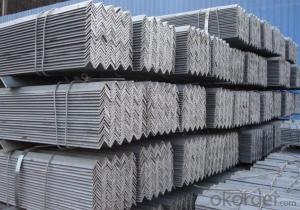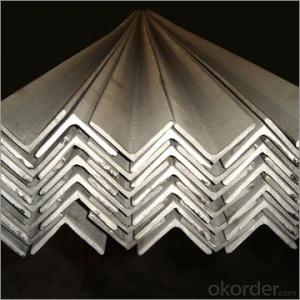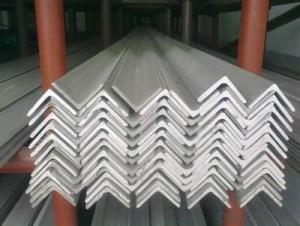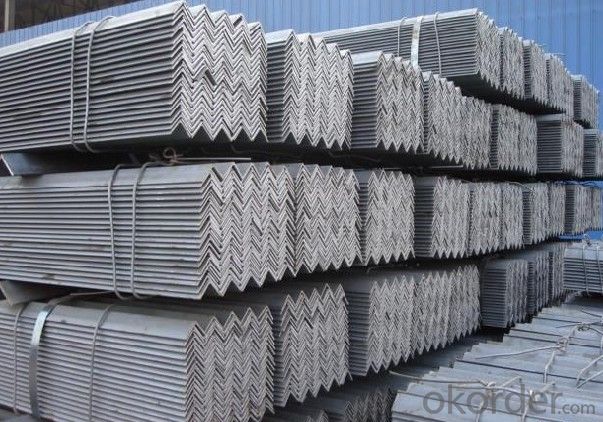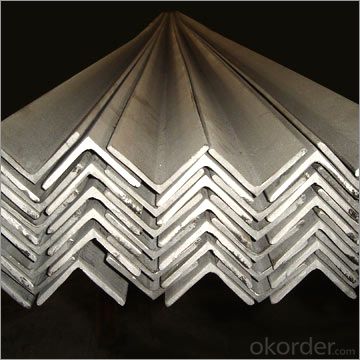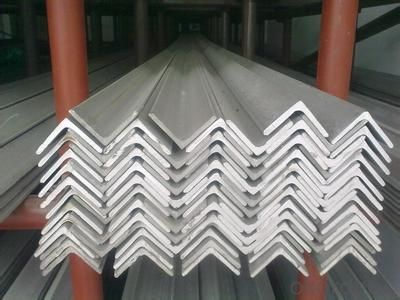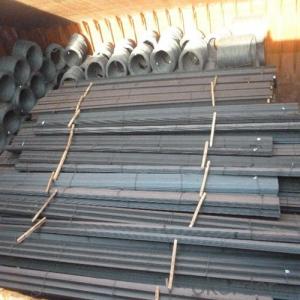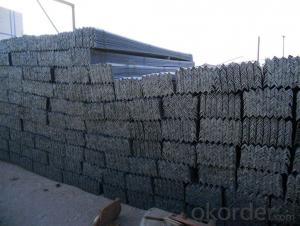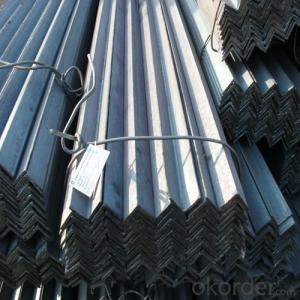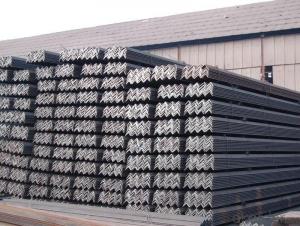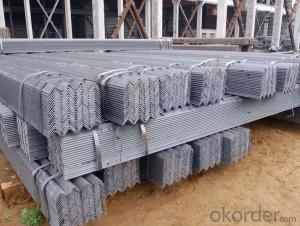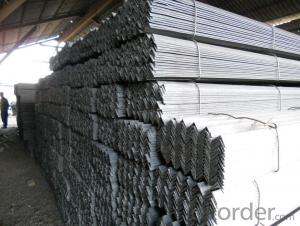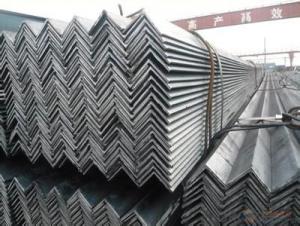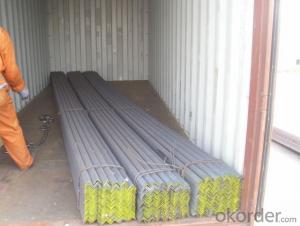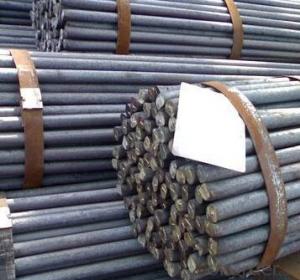Equal steel angle high quality ASTM A36 ou Q235
- Loading Port:
- China main port
- Payment Terms:
- TT OR LC
- Min Order Qty:
- 25 m.t.
- Supply Capability:
- 20000 m.t./month
OKorder Service Pledge
OKorder Financial Service
You Might Also Like
Angle steel Details:
| Minimum Order Quantity: | Unit: | m.t | Loading Port: | ||
| Supply Ability: | Payment Terms: | Package: | bundle |
Product Description:
Product Description:
Specifications of Angle Steel
1. Invoicing on theoretical weight or actual weight as customer request
2. Length: 6m, 9m, 12m as following table
3. Sizes
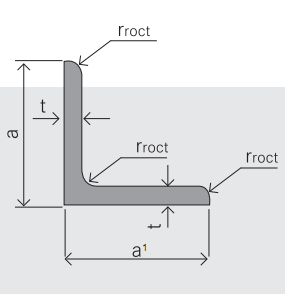
Sizes: 25mm-250mm | ||
a*t | ||
25*2.5-4.0 | 70*6.0-9.0 | 130*9.0-15 |
30*2.5-6.6 | 75*6.0-9.0 | 140*10-14 |
36*3.0-5.0 | 80*5.0-10 | 150*10-20 |
38*2.3-6.0 | 90*7.0-10 | 160*10-16 |
40*3.0-5.0 | 100*6.0-12 | 175*12-15 |
45*4.0-6.0 | 110*8.0-10 | 180*12-18 |
50*4.0-6.0 | 120*6.0-15 | 200*14-25 |
60*4.0-8.0 | 125*8.0-14 | 250*25 |
5. Payment terms:
1).100% irrevocable L/C at sight.
2).30% T/T prepaid and the balance against the copy of B/L.
3).30% T/T prepaid and the balance against L/C
6.Material details:
Alloy No | Grade | Element (%) | |||||
C | Mn | S | P | Si | |||
|
|
|
|
|
|
| |
Q235 | B | 0.12—0.20 | 0.3—0.7 | ≤0.045 | ≤0.045 | ≤0.3 | |
|
|
|
|
|
|
| |
Alloy No | Grade | Yielding strength point( Mpa) | |||||
Thickness (mm) | |||||||
≤16 | >16--40 | >40--60 | >60--100 | ||||
≥ | |||||||
|
|
|
|
|
| ||
Q235 | B | 235 | 225 | 215 | 205 | ||
Alloy No | Grade | Tensile strength (Mpa) | Elongation after fracture (%) | ||||
Thickness (mm) | |||||||
| ≤16 | >16--40 | >40--60 | >60--100 | |||
≥ | |||||||
|
|
|
|
|
|
| |
Q235 | B | 375--500 | 26 | 25 | 24 | 23 | |
Usage & Applications of Angle Steel
According to the needs of different structures, Angle can compose to different force support component, and also can be the connections between components. It is widely used in various building structures and engineering structures such as roof beams, bridges, transmission towers, hoisting machinery and transport machinery, ships, industrial furnaces, reaction tower, container frame and warehouse etc.
Packaging & Delivery of Angle Steel
1. Packing: it is nude packed in bundles by steel wire rod
2. Bundle weight: not more than 3.5MT for bulk vessel; less than 3 MT for container load
3. Marks:
Color marking: There will be color marking on both end of the bundle for the cargo delivered by bulk vessel. That makes it easily to distinguish at the destination port.
Tag mark: there will be tag mark tied up on the bundles. The information usually including supplier logo and name, product name, made in China, shipping marks and other information request by the customer.
If loading by container the marking is not needed, but we will prepare it as customer request.
Production flow of Angle Steel
Material prepare (billet) —heat up—rough rolling—precision rolling—cooling—packing—storage and transportation
- Q: What are the different surface finishes for steel angles?
- There are several different surface finishes available for steel angles, depending on the desired aesthetic and functional requirements. Some of the most common surface finishes for steel angles include: 1. Mill Finish: This is the most basic and untreated finish, which is obtained directly from the mill without any additional treatment. It has a rough and dull appearance, with visible mill scale and imperfections. 2. Hot-dip Galvanized: In this process, the steel angle is immersed in a bath of molten zinc, which forms a protective coating on the surface. This finish provides excellent corrosion resistance, making it suitable for outdoor and marine applications. 3. Powder Coated: Powder coating involves applying a dry powder to the steel angle and then curing it through heat, forming a durable and smooth finish. It offers a wide range of color options and provides good corrosion resistance and aesthetics. 4. Painted: Steel angles can be painted using various types of paint, such as enamel, epoxy, or acrylic. This finish not only enhances the appearance but also provides some level of protection against corrosion. 5. Stainless Steel: Steel angles can be made from stainless steel, which has a natural, corrosion-resistant surface finish. Stainless steel angles are commonly available in a brushed or polished finish, which provides a clean and shiny appearance. 6. Galvannealed: This is a specialized surface finish that involves galvanizing the steel angle and then heat treating it to form a matte, grayish finish. It offers good corrosion resistance and paint adhesion, making it suitable for applications requiring both. These are just a few of the different surface finishes available for steel angles. The choice of finish will depend on factors such as the intended use, environment, and desired appearance of the steel angle.
- Q: Are steel angles suitable for conveyor systems?
- Yes, steel angles are suitable for conveyor systems. Steel angles are often used in conveyor systems due to their strength, durability, and versatility. They provide a rigid structure that can support heavy loads and withstand the continuous motion and vibrations of a conveyor system. Steel angles can be easily welded or bolted together to create the framework for the conveyor system, allowing for easy customization and modification. Additionally, steel angles are resistant to corrosion, making them suitable for various environments and applications.
- Q: What is the use of angle steel and channel steel?
- Used to make steel structures, such as steel staircases, plant supports, etc..
- Q: How do steel angles contribute to the overall sustainability of a building?
- A building's overall sustainability is enhanced by steel angles in various ways. To begin with, steel angles are constructed from recycled materials, making them a sustainable choice for building purposes. Steel is one of the world's most recycled materials, boasting a high recycling rate. This reduces the necessity for new resources and lessens the environmental impact of extraction and production. Additionally, steel angles offer structural efficiency, enabling them to support greater loads with less material compared to other building materials. This efficiency reduces the amount of steel needed for construction, minimizing the carbon footprint associated with steel production and transportation. Furthermore, steel angles are extremely durable and long-lasting. They possess high resistance to corrosion, fire, and pests, thereby reducing the maintenance and replacement requirements over the building's lifespan. This durability results in reduced waste generation and lower life-cycle costs, ultimately making the building more sustainable in the long term. Moreover, steel angles are versatile and easily reusable or repurposed. In the event of renovation or demolition, salvaging and reusing the steel angles in other construction projects is feasible. This promotes a circular economy approach, minimizing waste generation and contributing to the overall sustainability of the construction industry. Lastly, steel angles possess excellent thermal properties that can enhance a building's energy efficiency. They can be utilized as part of the building envelope, aiding in the reduction of energy consumption for heating and cooling. By improving insulation and airtightness, steel angles contribute to lower energy demand and reduced greenhouse gas emissions. In conclusion, steel angles contribute to a building's overall sustainability through their recycled content, structural efficiency, durability, recyclability, and energy-saving properties. Opting for steel angles in construction allows for resource conservation, waste reduction, and a minimized environmental impact in the built environment.
- Q: How do you reinforce a steel angle for added strength?
- One way to reinforce a steel angle for added strength is by welding additional steel plates or gussets to the angle. This increases the cross-sectional area, effectively distributing the load over a larger surface area and improving its load-bearing capacity. Another method is to bolt or rivet steel plates to the angle, providing additional support and strength. Additionally, using thicker or higher-grade steel angles can also enhance their overall strength.
- Q: Can steel angles be used as framing members in buildings?
- Framing members in buildings can indeed utilize steel angles. These angles are commonly employed in construction to serve as a structural element for framing, bracing, and supporting various components of a building. With their exceptional strength, durability, and load-bearing capacity, they prove suitable for a wide range of applications in building construction. Steel angles possess the ability to form rigid frames, trusses, and connections, thereby providing stability and support to the structure. Moreover, they can be easily welded, bolted, or connected using other fastening methods, allowing for flexible and efficient construction. In essence, steel angles present themselves as a versatile and dependable choice for framing members in buildings.
- Q: What are the limitations of using steel angles in highly corrosive or chemical environments?
- The limitations of using steel angles in highly corrosive or chemical environments stem from the inherent nature of steel and its vulnerability to corrosion. To begin with, steel angles are primarily composed of carbon steel, which has a tendency to rust when exposed to moisture or chemicals. In environments with high corrosion potential, such as those containing acids, alkalis, or saltwater, the steel angles may corrode at an accelerated rate, which can compromise their structural integrity. Additionally, these steel angles may also experience pitting corrosion in such environments. Pitting corrosion occurs when localized chemical reactions result in the formation of small pits or holes on the steel surface. This phenomenon weakens the angles and diminishes their load-bearing capacity. Another drawback is that steel angles may lack resistance to specific chemicals or substances. Certain chemicals can trigger reactions with the steel, leading to degradation or even catastrophic failure. For example, strong acids or bases can inflict severe damage on the steel angles, potentially resulting in structural collapse. Moreover, steel angles in corrosive environments often require supplementary protective measures like coatings or corrosion inhibitors to enhance their resistance. However, implementing these additional measures can escalate the cost and maintenance demands of the structure. To summarize, while steel angles find widespread use in various applications, their suitability in highly corrosive or chemical environments is limited due to their susceptibility to corrosion and potential chemical reactions. It is crucial to consider alternative materials or employ protective measures to ensure the angles' structural integrity and longevity in such environments.
- Q: Can steel angles be used in machine frames?
- Yes, steel angles can be used in machine frames. Steel angles provide structural support and stability, making them suitable for constructing machine frames. They can withstand heavy loads and offer excellent resistance to bending and twisting forces, making them a popular choice in various industrial applications.
- Q: Are steel angles easy to install?
- Installing steel angles can be a relatively straightforward task, depending on the specific use and the expertise level. These angles are commonly employed in construction projects for structural support, reinforcement, and framing purposes. The installation procedure generally entails measuring, cutting, and securing the steel angles in the desired location using appropriate fasteners like screws, bolts, or welding. Nevertheless, it's worth noting that the ease of installation may vary depending on the project's complexity and the skills possessed by the individual or team carrying out the installation. Those with professional experience or expertise may find it easier to install steel angles due to their familiarity with the materials and techniques involved. Conversely, those lacking experience may require guidance or assistance from professionals to ensure proper installation and adherence to safety guidelines. In summary, with the correct tools, knowledge, and precautions, steel angles can be relatively easy to install. It is always advisable to follow the manufacturer's instructions, seek professional advice when necessary, and prioritize safety to achieve optimal results during the installation process.
- Q: Can steel angles be used for temporary or removable structures?
- Yes, steel angles can be used for temporary or removable structures. Steel angles provide structural support and stability, making them suitable for various applications such as scaffolding, temporary frames, or modular structures that can be easily assembled and disassembled.
Send your message to us
Equal steel angle high quality ASTM A36 ou Q235
- Loading Port:
- China main port
- Payment Terms:
- TT OR LC
- Min Order Qty:
- 25 m.t.
- Supply Capability:
- 20000 m.t./month
OKorder Service Pledge
OKorder Financial Service
Similar products
Hot products
Hot Searches
Related keywords
